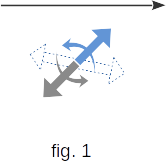From the Direct electric current
87. What is electric current?
If you look inside the 1960 radio, you will see weakly shimmering lamps, wires of colorful wires, round or rectangular capacitor boxes, coils on iron cores, etc. There are no moving parts here. But if you turn the tuning knob, you will hear music from London or Paris instead of broadcasting Chicago radio.
There's no visible movement inside the radio. Similarly, you will not notice any movement when you turn on a light bulb or an electric stove. But in fact, there is movement in the lamps and conductors of the receiver, in the filament of the light bulb or tile spiral! Electric current flows through all conductors connected to the voltage source.
Electric current, as you know from Book One physics, is the ordered movement of electrically charged particles.
We do not directly observe the movement of particles in a conductor. However, the presence of current in a conductor can be judged by the actions or phenomena that accompany the current.
First, the conductor through which the current flows is heated. Secondly, the electric current is able to allocate chemical components of the conductor, such as copper from copper sulfate solution. This process is called electrolysis (from the Greek "Lio" - split). Electrolysis is not observed in all conductors, but only in the so-called electrolytes. Electrolytes include aqueous solutions of acids, alkalis and salts as well as some chemical compounds in liquid or solid state.
Thirdly, current has a magnetic effect. The magnetic arrow near the conductor with the current rotates (fig. 1).

The magnetic action of current is observed in all cases without exception. The chemical action of current is observed only in electrolytes. There is no heating in superconductors (see section 94).
The listed current actions allow its use not only in simple devices such as an electric stove, electric motor or radio receiver.
Complicated computing machines and huge elementary particle accelerators, such as the Fermi Lab near Chicago, only work because the electric current is capable of performing the actions described above.